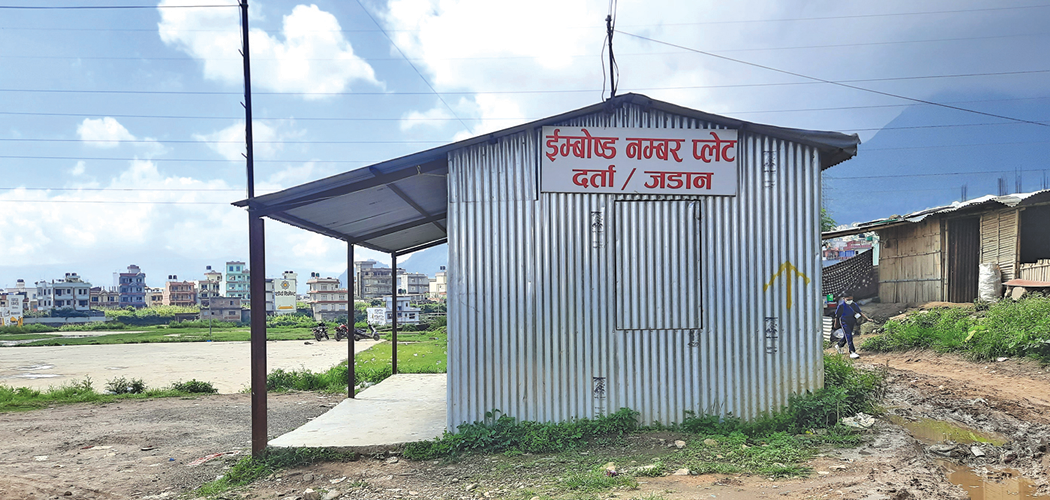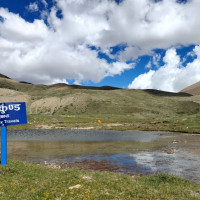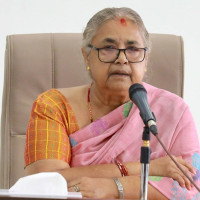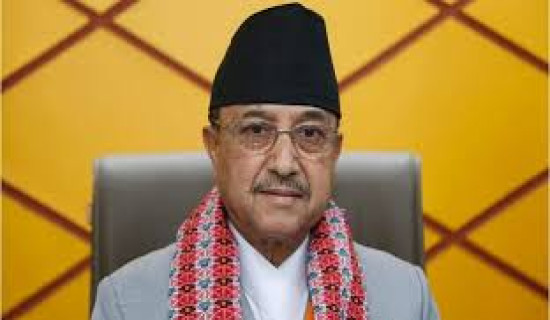- Saturday, 15 November 2025
The issue of introducing embossed number plates
Kathmandu, July 17: “Embossed number plate will be installed on vehicles, and Smart Card will replace the existing driving license” was one of the policies under the Three-Year Interim Plan (2007/08-2009/10) introduced by the National Planning Commission.
It was eight years later that the Department of Transport Management (DoTM), in 2015, called a tender to craft and distribute embossed number plates. It was awarded to Decatur-Tiger IT, a Bangladeshi company, on May 30, 2016, at $44 million.
As per the contract, 2.5 million vehicles were to be equipped with embossed number plates by mid-September, 2021. The deadline was extended by two years and four months until mid-November, 2023.
The latest data received from DoTM and Ministry of Physical Infrastructure and Transport (MoPIT) shows that 10 per cent of the agreed quantity of embossed number plates has been printed and only 10 per cent of the printed plates have been installed on vehicles.
“The contractor has printed 250,000 embossed number plates. Just over 25,000 vehicles only have installed them. The contractor says that it can provide all the agreed number of plates if needed but there is no demand from the public,” said Ishwori Datta Paneru, information officer at DoTM.
A compensation of 95 per cent of the agreed amount should be paid to the contractor if the government fails to acquire all 2.5 million plates.
Paneru, who is also a director at the department, stressed that regular requests to install embossed number plates have been disseminated as the step has been delayed unnecessarily. A legal battle and COVID-19 pandemic also caused delays.
In September, 2020, then Prime Minister KP Sharma Oli had directed to stop distribution of embossed number plates as his attention was drawn demanding use of Devnagari script rather than English. Since the machine cannot read the Devnagari script, the distribution continued from February 2022.
However, on February 22, 2018, the Supreme Court issued an interim order to stop issuing embossed number plates responding to the petition by Bharat Basnet. Basnet had demanded use of Devnagari script as well.
Responding to the legal battle, the apex court decided to withdrew its interim order in December, 2019, allowing the distribution of the number plates.
“Embossed number plates will be helpful in upgrading our transport sector. It will also assist in traffic management,” said Shiva Prasad Nepal, spokesperson for the MoPIT.
In an embossed number plate, letters and digits are embossed and it is equipped with a Radio Frequency Identification (RFID) microchip that
maintains uniformity in issuance of number plates and prevents duplication. Officials at DoTM informed that it can also be tracked but the software will be handled by country’s security agency. It has not been brought in use yet.
“The contractor has to install 10 RFID gates in the country – five inside the Valley and five outside. The areas have been identified and the contractor has prepared necessary hardware and software for it. We await permission to construct the structures on the road from the Department of Roads,” said Paneru. Whenever a vehicle with embossed number plate passes through a RFID gate, it is registered in the system. It is expected to provide necessary information on vehicular movement. While the government cites embossed number plates to be beneficial, it has not been accepted by the public as only a few have installed it.
“I asked the showroom to assist me in getting an embossed number plate while I was buying a motorcycle last year. They said it wasn’t necessary. I then went to Bagbazaar and had my number plate made in Rs. 500 using stickers,” said Roshan, who only wished to be identified by his first name.
Roshan had come to Bagbazaar on Friday to have his number plates remade as the previous one had been torn out. “I was stopped by a traffic officer and he told me to have it fixed soon as it could have me fined Rs. 1,500. I was also suggested to get the embossed number plate,” he said.
“However, when I inquired about the embossed number plates, I found it would cost me Rs. 2,500 and the process was lengthy costing me several days. So, I rather decided to pay Rs. 250 and have my number plate on back remade,” Roshan added.
While preparing stickers for Roshan’s motorcycle, the shopkeeper said, “One needs a number plate so they come and have it made as soon as they buy a new vehicle. However, if it gets worn out, people don’t trouble themselves. Many commoners with two-wheelers definitely find Rs. 2,500 for number plates expensive.”
Another person had arrived at the Gurjudhara-based Transport Management Office to have his blue-book renewed last week. The transport office is around 4.5 kilometres away from Kalanki and many find it far from the city. It is where two-wheeler owners should also visit for the embossed number plates.
The embossed number plate office in Gurjudhara, which is made up of tin sheets, is easily identified thanks to its sign board. “I saw the office and I wondered how long the process would take. I planned to install the plate if it was mandatory while renewing my blue-book, but since it wasn’t, I didn't bother to,” he said.
He also stressed that he saw on social media that the embossed number plates were not of good quality as they tore out and were unfit to install on some vehicles.
“In majority of two-wheelers the number plates can be easily fixed. In some scooters, we need to drill in the front as they don't have a number plate holder. It costs Rs. 100. It doesn’t harm the vehicle,” said the motorcycle garage owner nearby the embossed number plate office.
However, an official at the embossed number plate office informed that it was better than traditional number plates and it would only take an hour to receive the embossed number plate once an individual arrives there after applying online and with the voucher of Rs. 2,500 paid to the office’s account.
An individual should also have vehicle-related documents and citizenship while visiting the office.
“There are not many visitors due to which all necessary process gets completed within an hour including biometrics. If more start arriving, it will start taking some time,” the official said.
The registered vehicle number and the one on embossed number plate will be different. “When someone applies online, the software assigns a printed embossed number plate. The biometric and vehicle details of respective vehicle are then added in the respective plate’s database,” said Paneru.
Similarly, the colours for the texts have also been changed in embossed number plates and many said it only created confusion. Public vehicles have been allotted a yellow-coloured plate with black digits; government corporations’ vehicles used yellow number plates earlier.
Tourist vehicles, which used green number plates, will also receive similar plates as public vehicles.
Likewise, the embossed number plates cost Rs. 2,900 for three-wheelers, Rs. 3,200 for four-wheelers (light vehicles) and Rs. 3,600 for heavy vehicles. For light and heavy vehicles, the embossed number plates can be installed from the transport office in Ekantakuna.
An official at the embossed number plate office in Ekantakuna said that it would take more than a week for the embossed number plate to arrive after submitting necessary documents.
Recently, the department has been citing a notice from the Nepal Gazette which informs the public to install embossed number plates on their vehicles mandatorily. The notice published in the Nepal Gazette on November 8, 2021, states that embossed number plates should be installed on vehicles registered in five provinces –
Bagmati, Gandaki, Sudurpashchim, Lumbini and Karnali.
Embossed plates are not distributed from Province 1 as it hasn’t been named yet. Similarly, Province 2 was named as Madhes Province only in January, 2022.
On June 3, the DoTM published a notice making embossed number plates mandatory for all vehicles operating in Bagmati and Gandaki provinces by July 17.
Meanwhile, distributing the number plates has not been started in other three provinces citing lack of infrastructure there.
Transport related issues are addressed by provincial governments. However, embossed number plate issues are being addressed by central government and department but provinces are expected to help them as vehicle registration falls under provincial jurisdiction.
“It is a rule implemented from the central government and we can’t say no. We will request public to install it but won’t make it mandatory because there are still several reservations from the commoners’ side,” said Ghanashyam Dahal, Bagmati Province Minister for Labour, Employment and Transport.
Talking to The Rising Nepal, Minister Dahal informed that they were seeking a discussion with the central government regarding the issues of embossed number plates. “We have not been discussed regarding the implementation but our concerns remain unheard as we are not called for consultations,” said Dahal.
The provinces said they will continue with the implementation but meeting the target is a colossal task.
Spokesperson for Gandaki Province Ministry of Physical Infrastructure, Urban Development and Transport Management Tikaram Paudel said that they can accept 40-50 vehicles daily and provide them with embossed number plates.
“The Kaski-based Transport Office alone distributes embossed number plates for entire Gandaki province. If the public were to start seeking embossed number plates eagerly , it would create a very long queue,” said Paudel.
However, if the demand rose, the ministry plans to add new offices for the task. Officials in Gandaki also said that making it mandatory could cause a boomerang from public as they were completely uninterested to install it in the present state.



-original-thumb.jpg)



-square-thumb.jpg)









